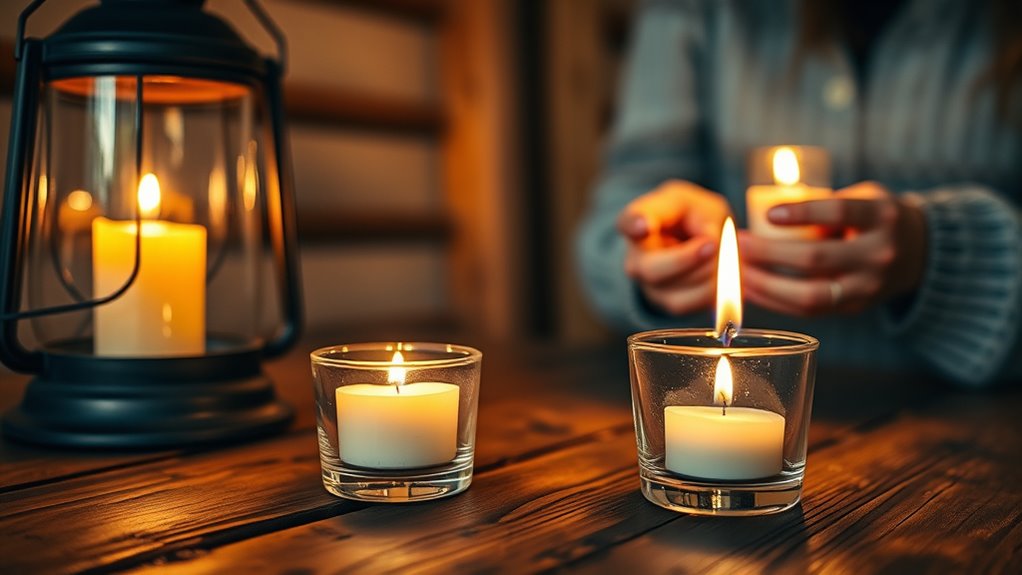To use candles and lanterns safely, choose products with safety certifications, stable bases, and made from fire-resistant materials. Always trim wicks, place them on heat-resistant surfaces away from flammable items, and never leave them unattended. Keep them out of reach of children and pets, and extinguish flames fully before leaving or sleeping. Following these guidelines helps prevent accidents—continue exploring for more tips to keep your space safe and cozy.
Key Takeaways
- Choose fire-resistant, certified candles and lanterns, and always use stable, heat-resistant surfaces for placement.
- Trim wicks regularly, keep flames away from flammable objects, and extinguish flames completely before leaving or sleeping.
- Never leave lit candles unattended, keep out of children’s and pets’ reach, and use protective shields or automatic shut-offs.
- Place candles on flat surfaces, avoid overcrowding, and use non-flammable trays or coasters for added safety.
- In emergencies, stay calm, smother small fires, evacuate if needed, and call 911 for uncontrolled fires.
How Do I Choose Safe Candles and Lanterns for My Home?

Choosing safe candles and lanterns begins with understanding the importance of quality and proper features. Start by checking the candle wick; regular wick trimming prevents excessive soot and reduces fire risk. A trimmed wick ensures a cleaner, steadier flame, lowering the chance of accidents. For lanterns, prioritize lantern material safety by selecting models made from fire-resistant or non-flammable materials like metal or glass. Avoid lanterns with flimsy or combustible components. Also, verify the candle or lantern’s certification for safety standards. Choose candles with stable bases to prevent tipping. By paying attention to these details—candle wick trimming and lantern material safety—you ensure your home remains safe while enjoying ambient lighting. Incorporating safety standards from reputable sources helps you make informed choices, preventing hazards and enhancing your peace of mind.
What Are the Best Practices for Lighting and Extinguishing Candles?
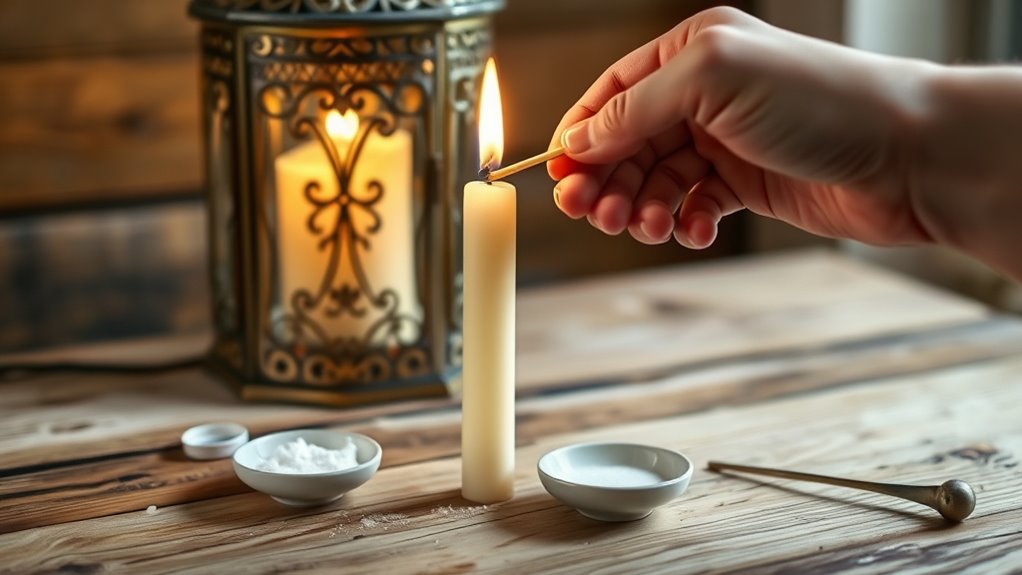
To keep your candles safe, start by using proper lighting techniques, like trimming the wick and avoiding overflows. When it’s time to extinguish, use a snuffer or gently blow out the flame without splashing wax. Regular candle maintenance, such as cleaning the holder and checking for damage, helps prevent accidents and keeps your candles burning safely. Additionally, placing candles on a stable, heat-resistant surface and away from airflow obstructions ensures better safety and combustion.
Proper Lighting Techniques
Proper lighting techniques are essential for safely using candles and lanterns. They help prevent accidents and ensure your flame stays controlled. Start by choosing a proper placement—keep candles on stable, heat-resistant surfaces away from drafts and flammable materials. Use long lighters or matches to ignite the wick safely, avoiding splashes or spills. When lighting, hold the flame close to the wick, allowing it to catch evenly. Always keep your hands steady and avoid rushing the process. Remember, never leave a lit candle unattended or move it while burning. To ensure safety, follow these best practices:
- Use a long match or lighter for ignition
- Keep flames away from drafts and curtains
- Ensure proper placement on stable surfaces
- Avoid overextending the wick during lighting
- Never rush the lighting process
Safe Extinguishing Methods
When it’s time to extinguish a candle, doing so safely helps prevent accidents and damage. The best method is to use a snuffer or gently blow out the flame, avoiding splattering hot wax. Before extinguishing, ensure the candle is in a fire-resistant container to contain any drips or sparks. Always check that the wick is trimmed to about a quarter inch before relighting; this prevents excessive soot and ensures a controlled burn. Never leave a burning candle unattended, especially during extinguishing. If you notice a flickering or smoky flame, extinguish it promptly. After putting it out, make sure the wick is completely out and no smoke is visible. Practicing these safe extinguishing techniques keeps your space secure and your candles in good condition. Proper extinguishing methods are an essential part of fire safety in candle use.
Candle Maintenance Tips
Lighting and extinguishing candles safely involves a few simple but important practices. To keep your candles burning beautifully and safely, always trim the wick to about ¼ inch before lighting. This prevents excessive smoke and uneven burning. Use decorative accessories like candle holders that are heat-resistant and stable. When lighting, avoid drafts that can cause uneven flames or flickering. Once lit, keep the candle free of debris, including wick trimmings, to prevent flare-ups. To extinguish, use a snuffer or gently blow out the flame—never leave it smoldering. Remember to keep candles away from curtains and other flammable objects. Proper maintenance guarantees your candles stay safe, emit a clean burn, and add charm to your space. Incorporating curiosity-driven practices such as exploring different candle styles or scents can enhance your overall experience and safety.
How Can I Prevent Fire Hazards When Using Candles and Lanterns?

To prevent fire hazards when using candles and lanterns, always place them on stable, heat-resistant surfaces away from flammable materials. Using surfaces made of fire-resistant materials helps contain potential accidents and reduces the risk of fires. Check that your candles and lanterns have proper safety certifications, ensuring they meet safety standards. Never leave lit candles unattended, and keep them out of reach of children and pets. Trim wicks regularly to prevent excessive flames, and avoid overcrowding a space with multiple open flames. Using high-quality, safety-certified products minimizes the risk of malfunction or accidents. Be aware of state-specific tax laws related to your retirement accounts to avoid unexpected liabilities. By following these precautions, you markedly reduce fire hazards and enjoy your candles and lanterns safely.
Are There Specific Placement Tips to Keep My Space Safe?
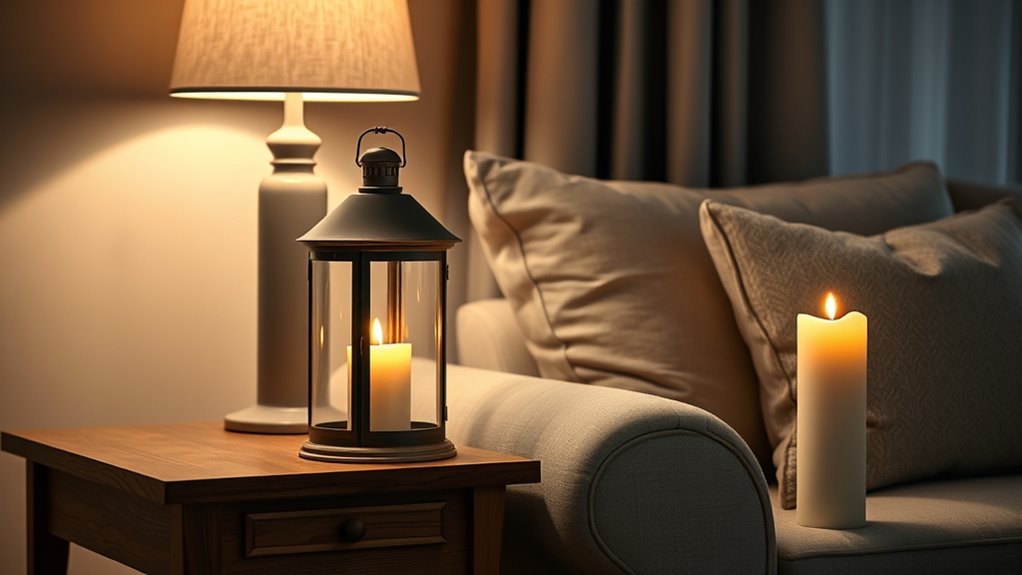
Ensuring proper placement of candles and lanterns is essential for maintaining a safe environment. Correct placement safety minimizes fire risks and enhances your decorative arrangements. Keep candles away from curtains, paper, or anything flammable. Place lanterns on stable, flat surfaces to prevent tipping. Avoid high-traffic areas where accidental bumps could occur. Use non-flammable coasters or trays for added protection. Keep candles and lanterns out of reach of children and pets. Ensure they are not near vents or drafts that can cause uneven burning or tipping. Consider using safety guidelines to further reduce potential hazards and ensure your space remains secure. Thoughtful placement enhances your decorative arrangements without compromising safety. By following these tips, you create a cozy, beautiful space that’s both inviting and secure. Proper placement safety makes all the difference in enjoying your candles worry-free.
What Safety Features Should I Look for in Candles and Lanterns?
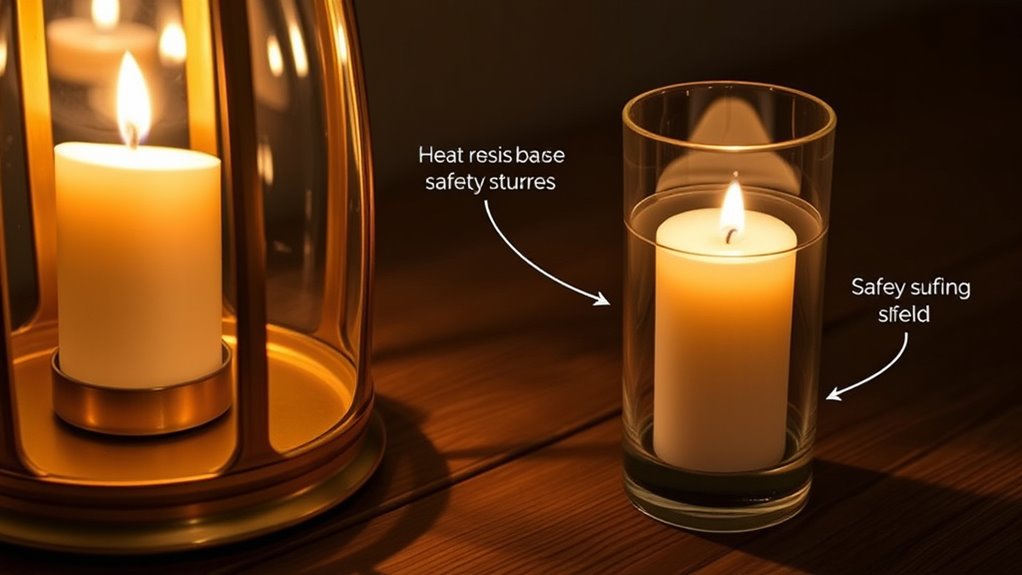
When choosing candles and lanterns, looking for built-in safety features can considerably reduce fire risks and enhance your peace of mind. Seek products made from fire resistant materials, such as tempered glass or metal, which help contain flames and prevent accidental fires. Flame retardant features, like protective shields or covers, are also vital; they can extinguish flames quickly if they come into contact with flammable surfaces or materials. Additionally, check for stable bases that prevent tipping and automatic shut-off mechanisms that turn off the flame if it gets too high or if the candle is left unattended. These safety features work together to minimize hazards, giving you confidence that your candle or lantern is safer to use in your home or outdoor space. Moreover, choosing Vetted products ensures you get reliable safety features backed by reviews and testing.
How Can I Safely Use Candles With Children and Pets Around?
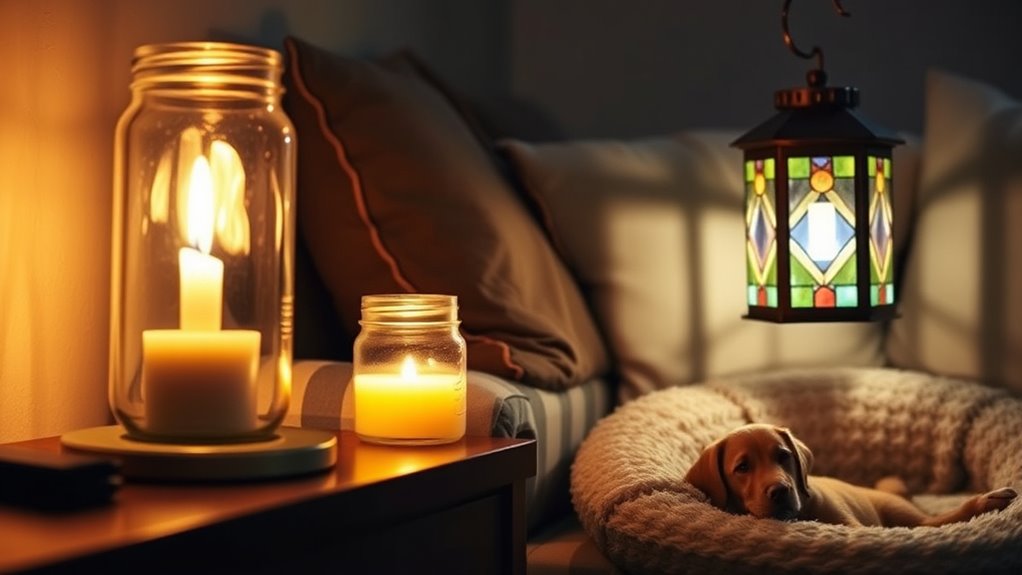
Safety features like stable bases and automatic shut-offs help prevent accidents with candles and lanterns, but extra precautions are necessary when children and pets are nearby. To keep everyone safe, consider implementing child proofing measures and using pet safe containers. Here are some tips:
- Keep candles out of children’s reach, ideally on high, secure surfaces
- Use pet safe containers that are sturdy and escape-proof
- Never leave lit candles unattended around kids or animals
- Educate children about fire dangers and proper candle handling
- Create a designated safe zone for candles away from pets’ access
- Choose suitable planters designed with safety features to ensure stability and reduce accidents
What Should I Do in Case of a Candle or Lantern Fire Emergency?
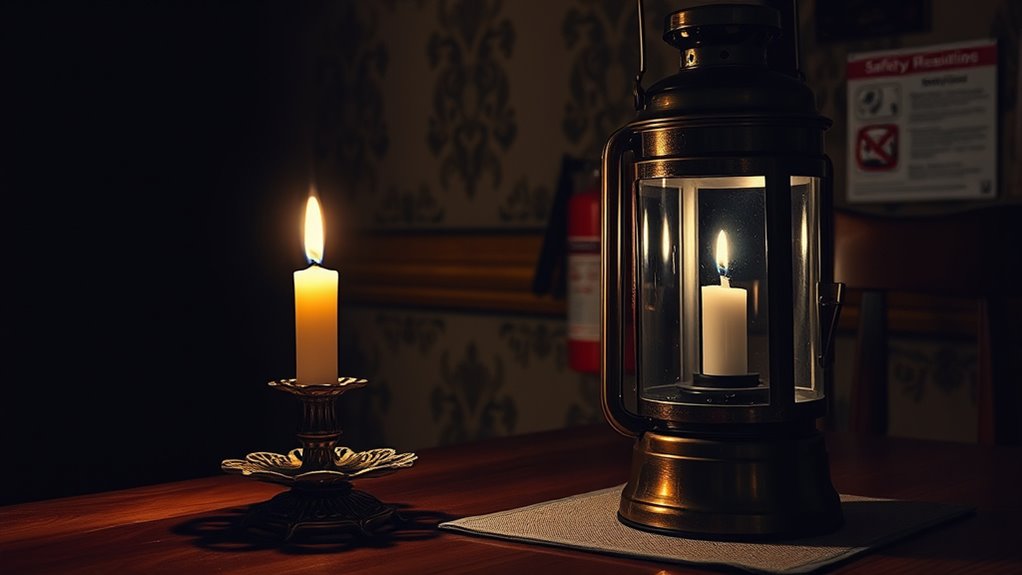
If a candle or lantern catches fire, stay calm and act quickly. Extinguish the flames safely if you can, then evacuate the area and call 911. Your prompt response can help prevent further damage or injury. Additionally, ensure that you are aware of fire safety protocols to better handle such emergencies.
Stay Calm and Act
Remaining calm is essential when a candle or lantern fire suddenly starts. Panicking can make the situation worse. Quickly assess the fire’s size and source. If it’s small, use a fire-resistant container or smother it with a fire-resistant lid or damp cloth. Never try to move a burning decorative candle holder with flammable surroundings. If the fire is out of control, evacuate immediately and call 911. Keep a fire extinguisher nearby, specifically a class B or multipurpose extinguisher. Remember, safety comes first, so don’t hesitate to seek help. Prevent future incidents by trimming wicks, placing candles on stable surfaces, and using fire-resistant containers. Proper fire safety techniques can significantly reduce risks during such emergencies. Stay alert, act swiftly, and always prioritize your safety and that of others around you.
Extinguish Safely Immediately
When you notice a candle or lantern fire getting out of control, quick action can prevent disaster. First, if you have fire resistant containers nearby, use them to safely extinguish the flames. Always extinguish immediately to prevent the fire from spreading or causing further damage. Avoid blowing on the flames, as this can spread hot wax or sparks. Instead, smother the fire with a fire-resistant lid or snuffer designed for candles and lanterns. If the fire is small and manageable, carefully place the flame into a fire resistant container to put it out safely. Remember, acting swiftly and using the right tools can make all the difference in keeping everyone safe and preventing a small fire from becoming a major emergency.
Evacuate and Call 911
In the event of a candle or lantern fire that you can’t control, your first priority is to make certain everyone’s safety by evacuating the area immediately. Quickly alert others, activate the fire alarm if available, and head for the nearest emergency exit. Don’t try to extinguish the flames yourself if they’re out of control—call 911 right away. Remember these steps:
- Ensure everyone leaves the building promptly
- Avoid using elevators during evacuation
- Stay low to avoid smoke inhalation
- Keep calm and follow the emergency exit signs
- Once outside, move to a safe distance and wait for emergency responders
Your quick action can save lives. Always prioritize safety, and never re-enter the building until authorities declare it safe.
How Can I Maintain and Extinguish Candles Properly for Longevity and Safety?

To guarantee your candles last longer and stay safe to use, it’s important to maintain and extinguish them properly. Regularly trim the candle wick to about a quarter-inch before each use; this prevents excessive flickering and soot buildup. When extinguishing a candle, use a snuffer or gently blow it out, avoiding splattering hot wax. Keep safety in mind if you’re using lanterns—replace batteries as needed to ensure consistent illumination and prevent accidents. If your lantern uses candles, check the wick and trim it regularly for even burning. Always ensure the flame is completely out before leaving the room or going to sleep. Proper maintenance and safe extinguishing practices help maximize your candles’ longevity and reduce fire risks.
Frequently Asked Questions
Can I Leave Candles Unattended Overnight Safely?
You shouldn’t leave candles unattended overnight, as it risks fire hazards. Always extinguish candles by candle snuffing before bed, ensuring the flame is out completely. Proper lantern placement is vital—keep lanterns on stable, heat-resistant surfaces away from curtains and flammable objects. Never leave a lit lantern or candle unattended for long periods, especially overnight, to keep your home safe.
Are There Eco-Friendly or Non-Toxic Candle Options?
If you’re looking for eco-friendly candles, consider ones made with sustainable ingredients like soy or beeswax, which burn cleaner and are biodegradable. For example, a family switched to soy candles in their home, reducing indoor toxins and waste. These candles often come in biodegradable packaging, making them a greener choice overall. You can enjoy cozy ambiance while supporting environmental health without sacrificing quality or safety.
How Do I Clean Soot or Wax Drips Safely?
To clean soot or wax drips safely, start by letting the candle cool completely. Carefully remove the wick if necessary, using wick removal tools. Gently scrape excess wax with a plastic spatula or cloth, avoiding sharp objects. For soot cleaning, use a soft brush or a damp cloth to wipe the area, ensuring you don’t spread soot further. Always handle with care to prevent damage or injury.
What Should I Do if a Lantern Tips Over?
If your lantern tips over, don’t panic—quickly grab a fire extinguisher if needed, and carefully move it to a safe, stable spot away from flammable materials. Remember, proper lantern placement can prevent accidents, so always set it on a flat, heat-resistant surface. Sometimes, a small misstep reveals the importance of vigilance, reminding you that safety measures are the true foundation of enjoying your lanterns confidently.
Are There Specific Safety Tips for Outdoor Candle Use?
When using candles outdoors, always place them in fire-resistant holders to prevent accidents. Make certain wind protection by shielding flames with lanterns or barriers, which helps keep the flames steady and reduces the risk of tipping over. Never leave candles unattended, especially in breezy conditions. By taking these precautions, you create a safer environment while enjoying your outdoor space, making sure everyone stays safe and your candles stay put.
Conclusion
By following these safety tips, you turn everyday candle and lantern use into a mindful art, transforming flickering flames from potential hazards into warm, comforting lights. Remember, safety isn’t just about precautions—it’s about creating a sanctuary where beauty and security coexist. When you prioritize careful placement, proper extinguishing, and child and pet safety, you illuminate more than just rooms—you illuminate peace of mind, proving that cautiousness is the true glow that guides us home.
